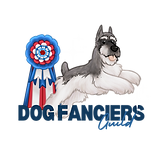
Canine Good Citizenship
The Dog Fanciers Guild Canine Good Citizenship certification is a pass or fail style test that evaluates a dog's ability to adapt to everyday life with people. The Canine Good Citizenship program promotes well mannered dogs and responsible handlers.
Rewards
Completion of the Canine Good Citizenship program earns you a certificate and a 500 DFG$ payout on the discord.
_edited.jpg)
How to Participate
Players must depict their dog completing three (3) out of the ten prompts listed below. Depictions of mistakes do not negatively impact your scores. Once you have completed your artwork please post them to the Discord under the #CertificationApplications channel. When an admin is available to process your test you will be awarded your DFG$ and a Canine Good Citizen certificate will be sent to your DMs.
Art Work Requirements
-
Fullbody - Dogs must be at least 75% visible
-
Handler - at least 50% of a humanoid handler must be visible
-
Background - a complete background with at least three distinct elements must be depicted
-
Colored - monochromatic or grayscale entries are allowed
Canine Good Citizenship Prompts
-
Accepting a friendly stranger
The dog must remain in a sit, or down, while the handler is approached by the test evaluator. He must not show any signs of shyness or resentment and he may not break from his sit/down. The evaluator should shake hands with the handler and exchange greetings and pleasantries.
-
Sitting politely for petting
The handler must place the dog in a heel, sit, or down and the dog must remain there for the duration of the test. The evaluator will then pet the dog on his head and body and the dog must tolerate this affection without resentment or shyness.
-
Appearance and grooming
The handler should present a grooming tool (brush or comb) that is regularly used in the general maintenance of the dog. The evaluator will use the tool to brush the dog's body. The evaluator must also handle the dogs ears and paws the dog must be complaint with this assessment. Dirty, unkempt, or otherwise ungroomed dogs should not pass.
-
Loose Leash Walking
The dog may walk on either side of the handler, his position should indicate that the dog is paying close attention to the handler and is responsive to the handler’s movement, speed, and any changes of direction. This test should include a turn to the left and right, an about turn, and at least one stop in between. The test concludes with a halt and sit. Any pulling on the leash should end the test and fail the dog.
-
Walking through a crowd
The dog and handler must walk around and pass pass through a crowd of people(at least three). The dog may show some interest in the strangers but should continue to walk with the handler, without evidence of over-excitement, shyness or resentment. The dog should not jump on people in the crowd or strain on the leash, these behaviors should fail the dog.
-
Sit, down, and stay in place
The dog should be on a 20 foot line to begin this test. He must be able to sit and down when cued by the handler. The handler then chooses the position for leaving the dog in the stay (sit or down). When instructed by the evaluator, the handler cues the dog to stay and walks forward the length of the line, turns, and returns to the dog at a natural pace. The dog must remain in the place in which it was left (it may not change position) until the evaluator instructs the handler to release the dog.
-
Coming when called
The dog should begin this test on a 20 foot line. Handlers may choose to tell dogs to “stay” or “wait” or they may simply walk away, giving no instructions to the dog. The handler will walk 10 feet from the dog, turn to face the dog, and call the dog. The handler may use encouragement to get the dog to come.
-
Reaction to another dog
Two handlers and their dogs approach each other from a distance of about 20 feet, stop, shake hands, and exchange pleasantries, they then continue on for about 10 feet. The dogs should show no more than casual interest in each other. Neither dog should go to the other dog or its handler.
-
Reaction to distraction
The evaluator will select and present two distractions. The dog may express natural interest and curiosity and/or may appear slightly startled but should not panic, try to run away, show aggressiveness, or bark. Examples of appropriate distractions include dropping a chair, rolling a crate dolly past the dog, having a jogger run in front of the dog, or dropping a crutch or cane.
-
Supervised separation
The Evaluator will approach the handler and say something like, “Would you like me to watch your dog?” Then, they take hold of the dog’s leash while the owner goes out of sight for three minutes. The dog does not have to stay in position but should not bark, whine, pace, or show any distress stronger than mild agitation or nervousness. Evaluators may talk to the dog but should not engage in excessive talking, petting, or management attempts.